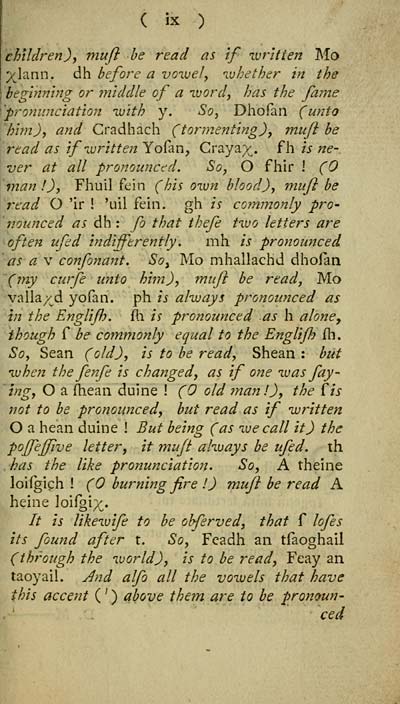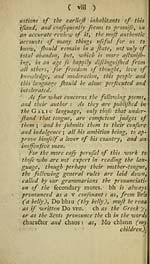J. F. Campbell Collection > Ais-eiridh na sean chánoin Albannaich; no, An nuadh oranaiche Gaidhealach
(25)
Download files
Complete book:
Individual page:
Thumbnail gallery: Grid view | List view

( ix )
ehUdren)y mufl he read as 'tf 'written Mo
p^lann. dh before a vo'weìy ivhether in the
hegìnnìng or mìddle of a -wordy has the fame
'prommciation ivith y. So, Dhofan (wtto
'him), and Cradhach (tonnenting)y muft he
read as ìfiuritten'^o^my Crayax,. fhisne-
ver at all pronounced. Soy O fhìr 1 (0
man !), Fhuil fcin (his oivn hIood)y mufl he
read O 'ir ! 'uil fein. gh is commonly pro-
' nounced as à\\'. fo that thefe tivo letters are
often ufed indifferently , mh is pronounced
' as a\ confonant. So^ Mo mhallachd dhofan
"(?ny curfe unto him)y mufl he read, Mo
valla/;d yofan. ph is always pronounced as
in the Engliflj. fli is pronounced as h alone,
though f be commonly equal to the Englifl) fh .
So, Sean (old), is to he read, Shean : but
ivhen the fenfe is changedy as if one ivas fay-
'ingy O a fhean duine ! (0 old man!)y the fis
not to be pronouncedy hut read as if written
O a hean duine ! But heìng (as ivecall it) the
poffeffive lettery it mufi ahvays be ufed. th
has the like pronunciation. So, A theine
loifgich ! (0 burning fire !) mufl he read A
heine loifgi/^,
// is likeivife to be ohferved, that f lofes
its found after t. So, Feadh an tfaoghail
(through the world), is to be ready Feay an
taoyail. And alfo all the voivels that have
thìs accent ( ' ) ahove them are to be pronoun-
ced
ehUdren)y mufl he read as 'tf 'written Mo
p^lann. dh before a vo'weìy ivhether in the
hegìnnìng or mìddle of a -wordy has the fame
'prommciation ivith y. So, Dhofan (wtto
'him), and Cradhach (tonnenting)y muft he
read as ìfiuritten'^o^my Crayax,. fhisne-
ver at all pronounced. Soy O fhìr 1 (0
man !), Fhuil fcin (his oivn hIood)y mufl he
read O 'ir ! 'uil fein. gh is commonly pro-
' nounced as à\\'. fo that thefe tivo letters are
often ufed indifferently , mh is pronounced
' as a\ confonant. So^ Mo mhallachd dhofan
"(?ny curfe unto him)y mufl he read, Mo
valla/;d yofan. ph is always pronounced as
in the Engliflj. fli is pronounced as h alone,
though f be commonly equal to the Englifl) fh .
So, Sean (old), is to he read, Shean : but
ivhen the fenfe is changedy as if one ivas fay-
'ingy O a fhean duine ! (0 old man!)y the fis
not to be pronouncedy hut read as if written
O a hean duine ! But heìng (as ivecall it) the
poffeffive lettery it mufi ahvays be ufed. th
has the like pronunciation. So, A theine
loifgich ! (0 burning fire !) mufl he read A
heine loifgi/^,
// is likeivife to be ohferved, that f lofes
its found after t. So, Feadh an tfaoghail
(through the world), is to be ready Feay an
taoyail. And alfo all the voivels that have
thìs accent ( ' ) ahove them are to be pronoun-
ced
Set display mode to: Large image | Transcription
Images and transcriptions on this page, including medium image downloads, may be used under the Creative Commons Attribution 4.0 International Licence unless otherwise stated. ![]()
| Early Gaelic Book Collections > J. F. Campbell Collection > Ais-eiridh na sean chánoin Albannaich; no, An nuadh oranaiche Gaidhealach > (25) |
|---|
| Permanent URL | https://digital.nls.uk/77282621 |
|---|
| Description | Volumes from a collection of 610 books rich in Highland folklore, Ossianic literature and other Celtic subjects. Many of the books annotated by John Francis Campbell of Islay, who assembled the collection. |
|---|
| Description | Selected items from five 'Special and Named Printed Collections'. Includes books in Gaelic and other Celtic languages, works about the Gaels, their languages, literature, culture and history. |
|---|

